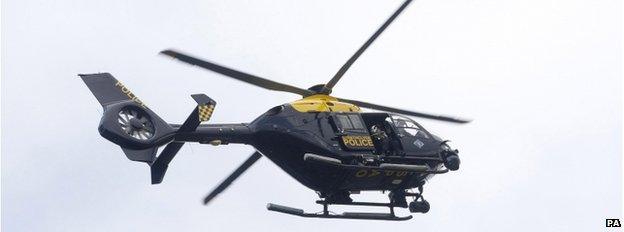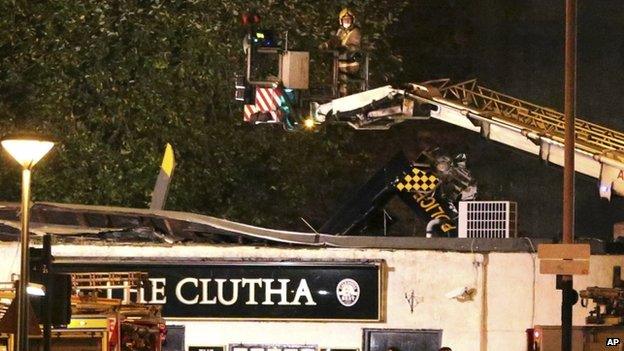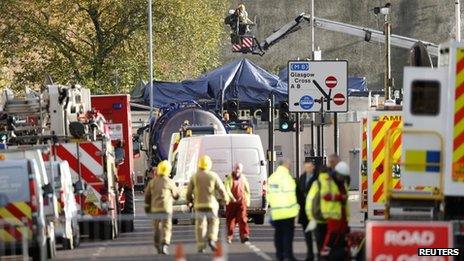Glasgow helicopter crash: What do we know about the aircraft?
- Published

Police Scotland's sole helicopter came down late on Friday night
Nine people are now known to have died after a helicopter crashed into a Glasgow pub. What do we know about the aircraft involved?
The Eurocopter EC-135 first entered service in 1996 and there are now more than 1,000 in operation.
It is widely used by police and ambulance services around the world.
Fifteen are operated by the National Police Air Service, covering England and Wales, while one of the Police Service of Northern Ireland's helicopters is an EC-135.
Police Scotland's sole aircraft - a regular sight in the skies above Glasgow - came down on Friday night.
It was a T2 model, a development of the older EC-135 T1.
It had been in service with what was, until April, Strathclyde Police and was leased from Bond Helicopters.
Aviation expert David Learmount said the aircraft was a "very sophisticated" twin-engine helicopter which could have flown with one working engine.
"If the pilot had had any control at all he would've aimed it away from a building," he said.
"The fact that he was not able to aim it away from the building tells us a great deal."
'Something happened'
He said even if both engines had failed, the helicopter would have been able to glide, using a method called "auto-rotation".
"This helicopter was unable to do that because it came down much faster than it would've done had the pilot been able to glide it," he said,
"So something happened. Something happened very suddenly and then the pilot either had no control at all or had very little control."

Eight people are known to have died in the crash
The aircraft was only seven years old, according to aviation consultant Chris Yates.
"It is a mystery at this time why this helicopter came down in such circumstances," he said.
'Pitched nose-down'
There have been suggestions the pilot may have tried to land the helicopter on the pub's flat roof.
But Mr Yates said: "It might be the case as we go through this investigation that he was literally at that very low altitude and didn't have much choice as to where the helicopter touched down."
He said the helicopter has a "reasonably decent safety record", and adds: "One would imagine this aircraft would be safer than most in its daily operations."
The helicopter was one of many that underwent safety checks as a precaution on the advice of its operator Bond Air Services last July, but it was not withdrawn from service.
Eurocopter, the helicopter manufacturer, issued a safety information notice about its EC-135 fleet early last May after reports of cracks on the lower hub shaft flange of a helicopter in France.
Police Scotland said: "Following detailed inspection, in line with the latest airworthiness directive, no faults were identified and the force helicopter was available for operational deployment."

The helicopter crashed into The Clutha pub in Glasgow on Friday night
The crash comes six years after a privately-owned Eurocopter EC-135 T2 crashed in Essex.
In that incident the pilot and his wife were unhurt, but the aircraft was badly damaged.
An Air Accidents Investigation Branch (AAIB) report, external found: "The helicopter's autotrim in the Automatic Flight System disengaged and the helicopter pitched nose-down."
The AAIB recommended manufacturers Eurocopter review the Stability Augmentation System (SAS) switch system on EC-135 helicopters "to reduce the likelihood of inadvertent de-activation of the SAS".
The crash on Friday night was the third involving a police helicopter in the west of Scotland.
A decade ago another Eurocopter EC-135 came down during a search of woodland in east Ayrshire. All three men on board had what witnesses described as a "miraculous" escape.
The AAIB report into that incident concluded: "No defects were found with the helicopter or any of its systems which could account for the behaviour of the helicopter and the loss of control. "
And in 1990 a Bell Jetranger crashed in bad weather, killing Sgt Malcolm Herd and injuring the pilot and crew.
- Published30 November 2013
- Published30 November 2013
- Published30 November 2013